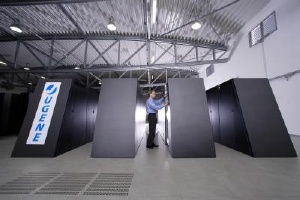Dec 4 2008
The investigation of complex materials such as high-temperature superconductors is problematic because of the presence of disorder and many competing interactions in real crystalline materials. "This makes it difficult to identify the role of specific interactions and, in particular, to decide whether repulsive interactions between electrons alone can explain high-temperature superconductivity," says Dr. Theodoulos Costi from the Institute of Solid State Research, Forschungszentrum Jülich, which is a member of the Helmholtz Association.
 Researchers from Juelich, Mainz and Cologne use ultracold atoms in an optical lattice as a construction kit for electronic materials. The theoretical calculations were made on Juelich supercomputers, e.g. JUGENE. Credit: Forschungszentrum Juelich
Researchers from Juelich, Mainz and Cologne use ultracold atoms in an optical lattice as a construction kit for electronic materials. The theoretical calculations were made on Juelich supercomputers, e.g. JUGENE. Credit: Forschungszentrum Juelich
Atoms in an optical lattice can serve as quantum simulators for many interesting phenomena such as that described above. They offer a very flexible model system in a clean and well-controlled environment and they can, for example, simulate electrons in solid, so-called condensed matter. In their technique, physicists introduce ultracold atoms into a crystal structure using an optical lattice and selectively switch this system between metallic and insulating states.
The physicists succeeded in simulating one of the most dramatic electronic phenomena with the aid of this quantum simulator: when the interactions between the electrons become too strong, a metal can suddenly become insulating. The resulting so-called Mott insulator is probably the most important example of a state of strong electronic interactions in condensed matter physics, as it is a starting point for the investigation of quantum magnetism. In addition, high-temperature superconductivity is found to arise in close proximity to this insulator.
The experimental setup in Mainz allows the density of the atoms and the strength of the repulsive interaction between the atoms to be tuned independently of each other. By investigating the behaviour of the atoms under compression and increasing interactions the experimentalists led by Prof. Immanuel Bloch of the Johannes Gutenberg University Mainz have been able to detect the Mott insulator in the quantum gas of the atoms.
A comparison with theoretical calculations by groups in Jülich and Cologne, requiring extensive simulations on a Jülich supercomputer, resulted in excellent agreement between theory and experiment. In addition, the researchers demonstrated through these calculations that one of the key methods of condensed matter theory, known by the abbreviation DMFT (dynamical mean field theory), is also applicable to real systems. The researchers expect that their theoretical and experimental techniques for investigating quantum many body states in optical lattices will soon be taken up by other groups.